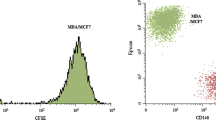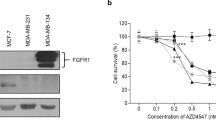Abstract
One-third of women with breast cancer will develop bone metastases and eventually die from disease progression at these sites. Therefore, we analyzed the ability of human MG-63 osteoblast-like cells (MG-63 cells), MG-63 conditioned media (MG-63 CM), insulin-like growth factor I (IGF-I), and transforming growth factor beta 1 (TGF-β1) to alter the effects of adriamycin on cell cycle and apoptosis of estrogen receptor negative (ER−) MDA-MB-231 and positive (ER+) MCF-7 breast cancer cells, using cell count, trypan blue exclusion, flow cytometry, detection of DNA fragmentation by simple agarose gel, and the terminal deoxynucleotidyl transferase (TdT)-mediated nick end-labeling method for apoptosis (TUNEL assay). Adriamycin arrested MCF-7 and MDA-MB-231 cells at G2/M phase in the cell cycle and inhibited cell growth. In addition, adriamycin arrested the MCF-7 cells at G1/G0 phase and induced apoptosis of MDA-MB-231 cells. Exogenous IGF-I partially neutralized the adriamycin cytotoxicity/cytostasis of cancer cells. MG-63 CM and TGF-β1 partially neutralized the adriamycin cytotoxicity of MDA-MB-231 cells but enhanced adriamycin blockade of MCF-7 cells at G1/G0 phase. MG-63 osteoblast-like cells inhibited growth of MCF-7 cells while promoting growth and rescued MDA-MB-231 cells from adriamycin apoptosis in a collagen co-culture system. These data suggest that osteoblast-derived growth factors can alter the chemotherapy response of breast cancer cells. Conceivably, host tissue (bone)–tumor cell interactions can modify the clinical response to chemotherapy in patients with advanced breast cancer.





Similar content being viewed by others
References
Koenders PG, Beex LVM, Langens R, Kloppenborg PWC, Smalls AGH, Benraad TJ, and the Breast Cancer Study Group. (1991) Steroid hormone receptor activity of primary human breast cancer and pattern of first metastasis. Breast Cancer Res. Treat. 18: 27–32.
Sherry MM, Greco AF, Johnson DH, Hainsmorth JD. (1986) Metastatic breast cancer confined to the skeletal system. Am. J. Med. 81: 381–386.
Coleman RE, Rubens RD. (1987) The clinical course of bone metastases from breast cancer. Br. J. Cancer 55: 61–66.
Diel IJ, Kaufman M, Goerner R, Costa SD, Kaul S, Bastert G. (1992) Detection of tumor cells in bone marrow of patients with primary breast cancer: a prognostic factor for distant metastasis. J. Clin. Oncol. 10: 21534–21539.
Theriault RL, Hortobagyl GN. (1992) Bone metastasis in breast cancer. Anticancer Drugs 3: 455–462.
Grondahl-Hanseb J, Christensen J, Rosenquist C, et al. (1993) High level of urokinase-type plasminogen activator and its inhibitor PAI-1 in cytosolic extracts of breast carcinomas are associated with poor prognosis. Cancer Res. 53: 2513–2521.
Koutsilieris M, Polychronakos C. (1992) Proteolytic activity against IGF-binding proteins involved in paracrine interactions prostate adenocarcinoma cells and osteoblasts. Anticancer Res. 12: 905–910.
Koutsilieris M, Frenette G, Lazure C, Lehoux JG, Govindan MV, Polychronakos C. (1993) Urokinase-type plasminogen activator: a paracrine factor regulating the bioavailability of IGFs in PA-III cell-induced osteoblastic metastases. Anticancer Res. 13: 481–486.
Koutsilieris M. (1994) Skeletal metastasis in advanced prostate cancer: cell biology and therapy. Crit. Rev. Oncol. Hematol. 18: 51–64.
Reyes-Moreno C, Sourla A, Choki I, Doillon C, Koutsilieris M. (1998) Osteoblast-derived survival factors can rescue PC-3 human prostate cancer cells from adriamycin-apoptosis, in vitro. Urology 52: 341–347.
Baserga R. (1995) The insulin-like growth factor I receptor: a key to tumor growth? Cancer Res. 55: 249–252.
Reddy KB, Mangold GI, Tandon AK, Yoneda T, Mundy GR, Zilberstein A, Osborne CK. (1992) Inhibition of breast cancer cell growth in vitro by a tyrosine kinase inhibitor. Cancer Res. 52: 3636–3641.
Kyprianou N, English HF, Davidson NE, Isaacs JT. (1991) Programmed cell death during regression of the MCF-7 human breast cancer following estrogen ablation. Cancer Res. 53: 162–166.
Teixeira C, Reed JC, Pratt MAC. (1995) Estrogen promotes chemotherapeutic drug resistance by a mechanism involving Bcl-2 proto-oncogene expression in human breast cancer cells. Cancer Res. 55: 3902–3907.
Perry RR, Kang Y, Greaves B. (1995) Effects of tamoxifen on growth and apoptosis of estrogen-dependent and -independent humam breast cancer cells. Ann. Surg. Oncol. 2: 238–145.
Elstner E, Linker-Israeli M, Said J, et al. (1995) Twenty (20)-epi-vitamin D3 analogues: a novel class of potent inhibitors of proliferation and inducers of differentiation of human breast cancer cell lines. Cancer Res. 55: 2822–2830.
Vandewalle B, Hornez L, Wattez N, Revillion F, Lefebvre J. (1995) Vitamin-D3 derivatives and breast-tumor cell growth: effect on intracellular calcium and apoptosis. Int. J Cancer 61: 806–811.
Geir A, Beery R, Haimsohn M, Hemi R, Malik Z, Karasik A. (1994) Epidermal growth factor, phorbol esters, and aurintricarboxylic acid are survival factors for MDA-231 cells exposed to adriamycin. In Vitro Cell Dev. Biol. Anim. 30(A): 867–874.
Boulanger J, Reyes-Moreno C, Koutsilieris M. (1995) Mediation of the glucocorticoid receptor (GR) function by the activation of latent transforming growth factor beta 1 in MG-63 osteoblasts-like osteosarcoma cells. Int. J. Cancer 62: 692–697.
Koutsilieris M, Reyes-Moreno C, Sourla A, Dimitriadou V, Choki I. (1997) Growth factors mediate glucocorticoid receptor function and dexamethasone-induced regression of osteoblastic lesions in hormone refractory prostate cancer. Anticancer Res. 17: 1461–1465.
Koutsilieris M, Sourla A, Pelletier G, Doillon C. (1994) Three-dimensional type I collagen gel system for the study of osteoblastic metastases produced by metastastic prostate cancer. J. Bone Miner. Res. 9: 1823–1832.
Sourla A, Doillon C, Koutsilieris M. (1996) Three-dimensional type I collagen gel system containing MG-63 osteoblasts-like cells as a model for studying local bone reaction caused by metastatic cancer cells. Anticancer Res. 16: 2773–2780.
Pollack A, Ciancio G. (1991) Cell cycle phase-specific analysis of cell viability using Hoechst 33342 and propidium iodide after ethanol preservation. In: Darzynkiewicz Z, Crissman HA (eds). Flow Cytometry. Academic Press, San Diego, pp. 19–24.
Oh Y, Muller HL, Ng L, Rosenfeld R. (1995) Transforming growth factor-b-induced cell growth inhibition in human breast cancer cells is mediated through insulin-like growth factor-binding protein-3 action. J. Biol. Chem. 270: 13589–13592.
Siwek B, Lacroix M, dePollak C, Marie P, Body JJ. (1997) Secretory products of breast cancer cells specifically affect human osteoblastic cells: partial purification of active factors. J. Bone Miner. Res. 12: 552–560.
Evans CE, Ward C, Braidman IP. (1991) Breast carcinomas synthesize factors which influence osteoblast-like cells indecently of osteoclast in vitro. J. Endocrinol. 128: R5–R8.
Galasco CSB. (1982) Mechanisms of lytic and blastic metastatic disease of bone. Clin. Orthopaed. Rel. Res. 12: 20–27.
Fornari FA, Randolph JK, Yalowich JC, Ritke MK, Gewirtz DA. (1994) Interference with DNA unwinding by doxorubicin in MCF-7 breast tumor cells. Mol. Pharmacol. 46: 649–656.
Goldenberg GJ, Wang H, Blair GW. (1986) Resistance to adriamycin: relationship of cytotoxicity to drug uptake and DNA single- and double-strand breakage in cloned cell lines of adriamycin-sensitive and resistant P388 leukemia. Cancer Res. 46: 2978–2983.
Doroshow JH. (1986). Prevention of doxorubicin-induced killing of MCF-7 human breast cancer cells by oxygen radical scavengers and iron chelating agents. Biochem. Biophys. Res. Commun. 135: 330–335.
Fornari FA, Jarvis WD, Grant S, et al. (1994) Induction of differentiation and growth arrest associated with nascent (nonoligosomal) DNA fragmentation and reduced c-myc expression in MCF-7 human breast tumor cells after continuous exposure to a sublethal concentration of doxorubicin. Cell Growth Differ. 5: 723–733.
Janvier R, Sourla A, Koutsilieris M, Doillon C. (1997) Stromal fibroblasts are required for PC-3 human prostate cancer cells to produce capillarylike formation of endothelial cells in a three-dimensional co-culture system. Anticancer Res. 17: 1551–1558.
Borsellino N, Belldegrun A, Bonavida B. (1995) Endogenous interleukin-6 is a resistance factor for cis-diamminedichloroplatinum and etoposide-mediated cytotoxicity of human prostate carcinoma cell lines. Cancer Res. 55: 4633–4639.
Párrizas M, Leroith D. (1997) Insulin-like growth factor-1 inhibition of apoptosis is associated with increased expression of the bcl-xL gene product. Endocrinology 138: 1355–1358.
Resnicoff M, Burgaud JL, Rotman HL, Abraham D, Baserga R. (1995) Correlation between apoptosis, tumorigenesis, and levels of insulin-like growth factor I receptor. Cancer Res. 55: 3739–3741.
Sell C, Baserga R, Rubin R. (1995) Insulin-like growth factor I (IGF-I) and the IGF-I receptor prevent etoposide-induced apoptosis. Cancer Res. 55: 302–306.
Resnicoff M, Abraham D, Yutanawiboonchai W, et al. (1995) The insulin-like growth factor I receptor protects tumor cells from apoptosis in vivo. Cancer Res. 55: 2463–2469.
Oltvai ZN, Korsmeyer SJ. (1996) Checkpoints of dueling dimmers foil death wishes. Cell 79: 189–192.
Gajewski TF, Thompson CB. (1996) Apoptosis meets signal transduction: elimination of a BAD influence. Cell 86: 589–592.
Zha J, Harada H, Yang E, Jockel J, Korsmeyer J. (1996) Serine phosphorylation of death agonist Bad in response to survival factor results in binding to 14-3-3 not Bcl-xL. Cell 87: 619–628.
Acknowledgments
Michael Koutsilieris is a scholar affiliated with the Fonds de la Recherche en Sante du Quebec (FRSQ) and is currently supported by the Central Council of Health of Greece (KESY). Carlos Reyes-Moreno holds a fellowship award from the FRSQ and Dr. Antigone Sourla is the recipient of a research fellowship award from Endorecherche, Research Center, Laval University, Quebec, Canada. The authors thank Mr. Maurice Dufour for excellent technical assistance with flow cytometry.
Author information
Authors and Affiliations
Corresponding author
Additional information
Communicated by A. G. Papavassiliou
Rights and permissions
About this article
Cite this article
Koutsilieris, M., Reyes-Moreno, C., Choki, I. et al. Chemotherapy Cytotoxicity of Human MCF-7 and MDA-MB 231 Breast Cancer Cells Is Altered by Osteoblast-Derived Growth Factors. Mol Med 5, 86–97 (1999). https://doi.org/10.1007/BF03402143
Accepted:
Published:
Issue Date:
DOI: https://doi.org/10.1007/BF03402143




